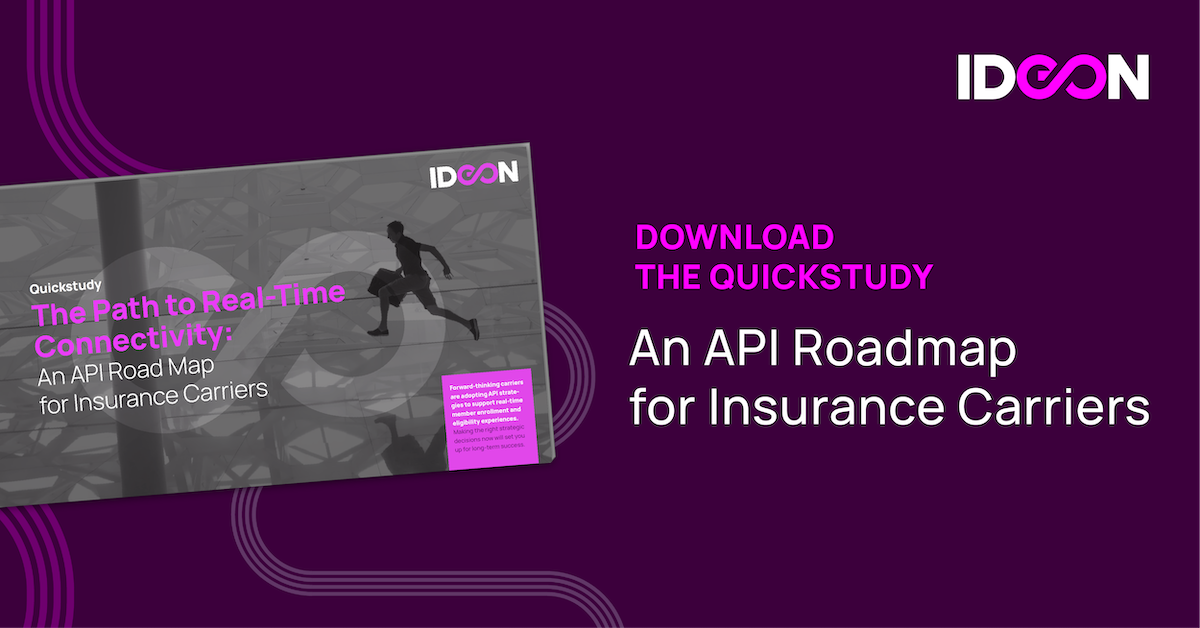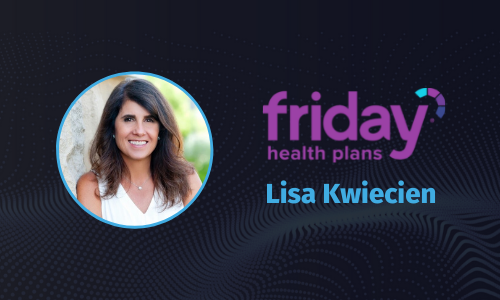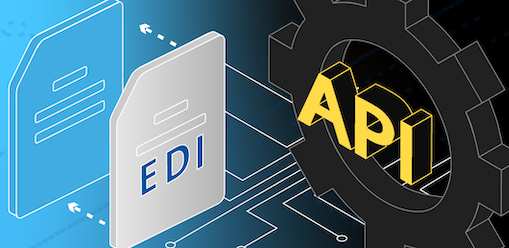In this Forbes article, Ideon CEO Michael Levin shares common challenges that keep large organizations from embracing digital transformation, and suggests four strategies that can help.
Topic: Carriers
Webinar: Leveraging API Middleware for Carrier Connectivity
A People-Centric Approach to Digital Transformation in Health Insurance
By Meg Collins, Ideon’s Chief Growth Officer
By now the argument is all too familiar: Digital transformation offers a host of attractive rewards, ranging from cost savings to improved customer experience.
That’s especially true in health insurance, an industry long dominated by established carriers skeptical of change but also being disrupted by new technology platforms reimagining benefits administration. In this rapidly evolving ecosystem, organizations that embrace digital change will inevitably emerge in a stronger competitive position.
But there’s a caveat. For digital transformation to be, well, transformative, it must be done right.
And that’s far easier said than done. According to research by consulting giant McKinsey, the success rate of organizational transformations in general is lower than 30%. Digital refittings—which require collaboration between multiple business groups—are even tougher to make work. Just 16% of respondents to the McKinsey survey said that digital transformation efforts at their organizations “have successfully improved performance and also equipped them to sustain changes in the long term.”
There are many reasons for this, but according to Boston Consulting Group one commonality reigns supreme: The human dimension is usually most vital to the outcome of attempted digital transformations.
In other words: Operating models, processes, and culture are at least as important to digital-transformation success as the technologies themselves. That’s certainly our experience at Ideon. With our APIs, we have successfully helped organizations in every corner of the health insurance and benefits ecosystem. But in doing so we have also observed the importance of a people-centric approach. And though every company is unique, the following four imperatives will go a long way to getting digital transformation right at any organization:
- Establish clear goals and governance. In planning stages, digital transformation should be attacked quasi-journalistically: What are we doing? Why are we doing this? Who is accepting ownership of this project? Where will we procure resources from? What is the sequence of events? Whether your organization seeks to replace legacy IT infrastructure or create an end-to-end customer experience, leaders should create a roadmap with quantifiable outcomes for digital transformation projects. But they must also be sure to make clear who “owns” each undertaking, instilling in each owner a clear understanding of how their work fits into the greater whole.
- Craft a compelling story. Many of the strongest reasons for dramatic change make for an uninspiring or anxiety-causing narrative. This is notably so with digital transformation, which many employees interpret as job-threatening. That’s why it’s crucial for leadership to craft a compelling story about where a company is headed and why wholesale change in technology and process is necessary. More often than not, that story involves improving the customer experience, but whatever the tale, it needs to be told and reinforced—via regular updates—so that all decisions can be easily understood as part of a meaningful journey.
- Assemble a complete team. Yes, having tech-savvy and tech-embracing people on transition teams is crucial. And yes, it’s important to include leaders from across an organization. But it’s also crucial to involve employees of all ranks and personality types wherever possible in planning and execution. First, because wholesale change inevitably impacts employees and workflows at all levels. But also because inclusion builds buy-in, increasing the likelihood that changing priorities, shifting tactics, and other crucial information is widely disseminated. Nothing increases mistrust more than actual or perceived secrecy, and an inclusive transition team helps avoid that reality or perception. Finally, building a transformation team that accounts for personality types and roles lessens the likelihood that this extremely important endeavor will be derailed by unhealthy (and all-too-common) group dynamics.
- Encourage input. Digital transformation is usually messy and rarely without challenges. As a result, it’s important to provide all employees with a mechanism to comment on or contribute to transformation planning or execution in (relatively) real time. This fosters a valuable sense of ownership and investment, which helps to avoid internal resistance (a common-enough phenomenon that it has a name: “blocking”) and also overcome the inevitable glitches or missteps.
Digital transformation is almost always a momentous undertaking, but it need not be intimidating. Organizations that succeed in keeping people and culture top of mind are already halfway to meaningful change. We know this at Ideon, because we see it happen every day with our customers and partners. We can’t enable your entire transformation, but when it comes to revamping your digital connectivity strategy, Ideon is happy to help. Contact us to learn more!
The Path to Real-Time Connectivity: An API Road Map for Insurance Carriers
Asked & Answered: What group benefits carriers should know about LDEx
If you’re in the group benefits industry, you’ve probably heard the term LDEx, i.e., LIMRA Data Exchange Standards. Whether you’re actively adapting your systems to accept LDEx-formatted enrollment data or have only seen the term in passing, there’s a lot happening around this opportunity and, of course, a lot for carriers to consider.
LDEx won’t immediately solve all of our industry’s data exchange challenges, but it’s a step in the right direction. MetLife, Guardian, Sun Life, Aflac, and other industry leaders are members of the LIMRA committee tasked with developing the LDEx, reflecting its transformative potential. Some carriers, however, have a myriad of questions.
Ideon, also a committee member, created this primer to answer basic questions about the standards and offer suggestions for leveraging them with minimal effort and expense.
What is LDEx?
The LIMRA Data Exchange (LDEx) Standards® are a set of rules—for terminology, formatting, content, and delivery—that facilitate digital communication between benefits administration (BenAdmin) platforms and insurance carriers. They are meant to replace various ad-hoc formats, such as EDI 834, for transmitting data about employee enrollment and eligibility in group benefit plans.
What are the benefits of LDEx for carriers?
If implemented broadly, LDEx will substantially reduce the complexity and expense of receiving enrollment information from BenAdmin platforms. Without LDEx, carriers typically spend weeks to months setting up and testing variations of EDI connections for each new group they enroll. If the industry uses LDEx, there will be greater consistency and accuracy throughout the integration and testing process, reducing the resources carriers must allocate to adding and managing groups.
As industry adoption increases, carriers will be able to connect more easily to benefits platforms and other insurance technology providers, dramatically improving the user experience for members who want to manage their eligibility through those platforms.
Ultimately, brokers, HR teams, and members will find that enrolling and modifying group benefits will be faster and more accurate. In today’s competitive environment, this is a business imperative for insurance carriers. Increasingly, brokers and BenAdmin platforms are steering their group clients to insurance carriers that make the enrollment experience as easy and automated as possible, across the software they use today.
Who created LDEx?
LDEx is sponsored by LIMRA, a non-profit consulting group and trade association that works primarily with the life insurance industry. The standards were developed by a steering committee composed of 40 executives from group benefits carriers and insurance technology companies.
What capabilities does LDEx provide?
The initial standards, released in January 2020, covered a wide range of benefits, including dental, vision, disability, critical illness, and life products. More recently, it has been expanded to include medical plans, flexible spending and health reimbursement accounts, paid family leave, and employee assistance programs.
The LDEx standard covers information about benefit enrollment, eligibility, and member changes. It also allows carriers to communicate data issues and coverage confirmations back to the BenAdmin provider.
The standards are designed to communicate transactions using structured XML files, a flat file format that’s common in the insurance industry. There are also near-term plans for LDEx to support REST APIs, which would allow for faster processing and better, automated error checking.
LIMRA is working on additional standards to support electronic communication of benefit plan designs and quotes.
What must carriers do to use LDEx?
The standards can be downloaded for free from LIMRA. Carriers must modify their existing enrollment systems to accept data in the new formats—or they can use separate data transformation software to convert each LDEx file they receive into the format their system uses.
How can carriers ease the burden of adopting LDEx?
Although LDEx will ultimately save time and money for carriers, adopting the standards can add development expenses for carriers already spreading limited technology resources across many priorities. Some carriers, however, are finding ways to adopt LDEx without devoting resources to development.
Ideon’s middleware solution enables carriers to accept LDEx files from numerous BenAdmins, with minimal development effort and capital costs, and no need to modify their current system and format. It’s not just a quick fix—it’s a long-term strategic move to enhance your connectivity with BenAdmins and set yourself up for scalability and adaptability in the future. Ideon radically reduces the time and effort needed to set up and administer group benefits, while delivering faster and more accurate information for employers and members. Reach out to us for more information.
Reimagining Enrollment Season: How Vericred Helps Carriers Transform Four Common Challenges into Opportunities
‘Easy to use, Easy to buy’: A Q&A with Friday Health Plans
In the past decade, several health insurance carriers have entered the individual and employer-sponsored markets, bringing innovative products and consumer-first digital experiences in a bid to compete with legacy carriers. One such entry is Friday Health Plans, a Colorado-based company launched in 2015 to serve the individual and small group markets. As Friday has expanded from a single-state carrier to a rapidly growing multi-state firm with $186 million in venture capital funding, digital technology has been a driving force behind its growth.
To learn more about the company’s growth strategy, Ideon spoke with Lisa Kwiecien, Friday’s director of channel development. The interview has been condensed and edited for clarity.
IDEON: What is Friday’s key differentiator?
KWIECIEN: We create health plans that are good value, easy to buy, and easy to use. We always put the consumer first, which is apparent in our plan designs.
How does technology help Friday compete against more established, national health plans?
Because we concentrate on individuals, families, and small groups, we have fewer plan designs, which means that our technology can be more focused and efficient. Tech helps make our plans easy to administer, straightforward to buy, and effortless to understand. That’s true for brokers, employers, and most especially consumers.
How so?
We’ve invested in technology across the company—in our app, in our telehealth function, in customer support. We’ve enhanced our ability to communicate with members, to help them access their ID cards digitally, to understand their deductibles and other plan details. They can also use our app to search for providers. We knew we had to be aligned with today’s consumer expectations generally.
Friday Health Plans recently started working with Ideon. Can you talk about that?
We work with Ideon in two ways. We share our plan and rate information with Ideon, which then distributes that data to third-party quoting platforms used by brokers, employers, and consumers. And we use Ideon to connect with benefits platforms [e.g., Rippling, GoCo, Decisely, Sequoia, Gusto], which helps us streamline digital enrollment and member management. We know we have great products and competitive rates, but we wanted to make the enrollment process more efficient for small businesses and for brokers. We needed to improve connectivity with today’s benefits ecosystem.
Why is connectivity with respect to brokers so important?
We pride ourselves on being a broker-friendly carrier. Many decisions by brokers are made because of convenience, so we want to make our products and technology as convenient as possible. We started to search for different ways that we can automate enrollment, because historically it’s been a super manual process to submit member and group enrollment information in the small group market. There’s a lot of back-and-forth. It’s inefficient. And often it still involves a lot of paper. Ideally, we want it so that brokers can digitally manage all transactions, submitting enrollments on their preferred platform so that we’re not working on different CSV files or PDFs, etc.
Why does uniformity like that matter?
For us, receiving a consistent file format from all these platforms improves our efficiency and accuracy, enabling us to seamlessly process incoming enrollments and member changes. And when we minimize errors, everything happens faster, creating a streamlined process. Members get their ID cards sooner, brokers have fewer fires to put out. We’re always working to build a streamlined process that flows smoother than it does today.
Does having better digital connectivity with benefits platforms factor into Friday’s growth plans?
Absolutely. It’s about scalability. When we anticipate our expansion into new markets and new states, we want to make sure that we have the technology in place to scale effectively. Enhancing our connectivity with benefits administration platforms is a prerequisite for scaling our business. That’s one reason why we’re working with Ideon.
Final question: Friday, which is a member of the HRA Council, supports Individual Coverage Health Reimbursement Arrangements (ICHRAs). How do ICHRAs fit into your company’s strategy?
We’re always thinking about how to improve affordability and optionality to employers and employees. There are a lot of reasons why ICHRAs might appeal to a small employer—e.g., cost predictability, class options—and ICHRA gives an employee more plan choices through the individual market than does a traditional small-group offering. They’re also tax-free and transportable. Our CEO, Sal Gentile, sees ICHRAs as a growth opportunity as they become more prevalent in the next few years.
Thanks so much for your time and candor, Lisa.
My pleasure.
To learn how benefits platforms can connect with Friday Health Plans, or for information about Ideon’s solutions for carriers, please reach out to support@ideonapi.com.
How third-party quoting platforms can drive better analytics and more sales for health insurance carriers
By Matt Leonard, Ideon’s Vice President of Carrier Relations
In recent years, brokers have flocked to third-party services to quote health insurance plans from multiple carriers. As a result, most carriers wanted to immediately tap into this new, growing distribution channel. They were quick to share rates and product information with external partners, making the downstream quoting process easy and accurate for brokers assembling employer proposals.
But not all carriers bought in. Holdouts chose to keep rates in-house, forcing brokers to obtain quotes directly from them. Their chief concern: a perceived black hole of visibility and analytics. Specifically, carriers worried they’d lose access to valuable information typically gleaned when brokers quoted plans via carrier websites and portals—e.g., which brokers sold what products (and where), what employer groups were shopping for new policies, etc.
Today, with a majority of health insurance carriers having made their plans and rates available to third-party quoting platforms, we can now see whether those early fears were justified.
Short answer: Carriers that embraced the “platform revolution” are being rewarded with a stream of high-quality data that can drive advanced analytics and turbocharge sales operations. In fact, their visibility into quoting activity on platforms is not all that different compared to if quotes are prepared on carrier websites. It’s truly a win-win—i.e., modern distribution combined with valuable insights.
Meanwhile, carriers that are not distributing their rates continue to miss out in two ways: limited distribution to digital sales channels and zero visibility into how—and if—their products are being quoted externally.
To understand why, let’s examine two scenarios.
- Carrier relies entirely on in-house website or portal for quoting
In the past, brokers logged on to each carrier’s website to get the quotes they needed to assemble a client proposal. That’s a lot of busy work for the broker, but it gave the carrier critical information. Location data, insights on which brokers are quoting which plans, and information about group sizes and quote-to-close ratios are all part of the typical carrier analytics package. And when they see quotes generated for potentially lucrative accounts, the carriers can assign sales representatives to help brokers to win the business.
This may seem like an appealing option to carriers that want full control over where their products are quoted. And, understandably, they crave these in-depth analytics. But this mindset—control over distribution—is built upon a false premise. Third-party quoting platforms still add the plan and rate information of non-participating carriers, mainly by tracking down public filings and other sources.
The difference? The data could well be incomplete or out-of-date, risking the possibility of inaccurate quotes appearing on client proposals. And carriers receive no information at all about how well their products are doing on downstream platforms and no leads on deals in progress. - Carrier engages with today’s platform ecosystem
Today, nearly all brokers use quoting platforms to save time compiling rates from multiple carriers and building proposals. Most carriers understand this reality and have reacted accordingly. These carriers distribute their product information to quoting platforms to ensure rates and plans are represented accurately.
At the same time, the participating carriers have access to a precise record of every quote issued, often specifying the individual broker, the employer group, and more.
Carriers can use this data to build sophisticated analytics that can help optimize the effectiveness of their marketing campaigns and commission programs. For example, they can calculate the quote-to-close ratio across different brokers, client types, geographic areas, and commission rates. Carriers are also feeding the data they get from quoting platforms directly into their CRM systems. That way their sales team can monitor how well they are being represented by each broker in the market and react quickly to opportunities.
Today, most carriers clearly see the two main advantages in working with platforms: distribution and visibility. The good news for those only now seeing the light is that they can catch up quickly, i.e., they need not build relationships with platforms from scratch. Middleware vendors, like Ideon, act as one-to-many distribution partners for carriers, accepting their plan data in any format and sharing it throughout today’s modern quoting ecosystem. And because a middleware partner pulls in quote activity and analytics from many downstream platforms, carriers get all the visibility they need to make informed decisions.
What are the opportunities that non-participating carriers are missing? Consider the recent experience of one new Ideon customer, a major health plan in the South, that recently started using our solutions to publish their plan information to quoting platforms. Until then, this carrier had assumed that most brokers were looking up their rates on their website. They were shocked when they looked at the analytics we delivered to find that brokers, using third-party platforms, were quoting their plans 600+ times per month. Before Ideon, the carrier had zero insight into these potential new business opportunities.
Now that’s a black hole to be concerned about. Contact us to learn more!
Arguing API vs EDI is Missing the Point
By Dan Langevin, Ideon co-founder and CTO
The evidence is in: APIs are the future. Across industries—in travel, healthcare, retail, marketing, hospitality, etc.—Application Programming Interfaces are the superior technology for real-time data exchange in complex digital ecosystems.
That’s no less the case in health insurance and employee benefits, industries for which it is essential that carriers, brokers, employers, and InsurTech companies be able to exchange accurate and up-to-date information that provides members (not to mention those brokers and employers) with the seamless digital experiences they’ve come to expect.
In fact, carrier executives today recognize that they must develop and deploy APIs for enrollment and eligibility or risk being left behind.
But if APIs are the future, the present is still dominated by EDI—Electronic Data Interchange—and migrating to the former from the latter will take many years and untold millions of dollars. Recognizing this, some carriers are trying to bolt an API onto their existing legacy technology. But this process can also take several years and cost millions of dollars—and still may not provide InsurTech platforms what they need most: real-time access to carrier systems with dependable data quality.
Missing in too many calculations around this issue is the fact that there’s a way to achieve API-like, near real-time synchrony and high data quality today, through EDI: Ideon’s infrastructure solution, which puts an API “wrapper” around EDI. This hybrid approach allows carriers to save money and deliver higher quality service to brokers, employers and plan participants now—and build APIs when they are ready.
To understand why a hybrid approach that incorporates EDI and APIs is best, for now, it helps to recall the evolution of the technologies that carriers deployed to manage members.
In the 1990s, the industry began to adopt an electronic method for brokers and employers to submit enrollment data through BenAdmins to carriers: EDI. But if EDI is a fine format for eligibility and demographic information, it is limited. In particular, EDI is asynchronous—i.e., a one-way transfer of information—so errors aren’t detected until after the file is submitted and an exception report is returned to the sender.
Moreover, the way the industry implemented EDI created as many problems as it solved. Each carrier developed its own EDI variant, requiring extra work from any broker, employer or technology company that needs to communicate with multiple carriers. Each carrier also has its own internal system for associating participants with plans, rates, networks and other details. These labels often don’t correspond to the way employers name plan options and describe them to workers, so the carriers needed another army, analysts, to clean up the data.
This resulted in two nettlesome consequences. First, because it takes time to review these EDI files, carriers limited how frequently they would accept them (generally, no more often than weekly). This gave rise to a two-week (or more) round trip, which contributed to poor experiences for employers, employees and brokers. For example, while an employee could use an HR app to, say, add a newborn dependent, they’d still have to wait two weeks for confirmation that the change was made correctly.
The second unfortunate consequence was that many carriers chose not to use EDI for small groups because they didn’t want costly analysts working on less significant accounts. So, for smaller groups, carriers asked brokers to enter enrollment data through broker portals. But if this sometimes reduced operating costs, it was—and is still—prone to errors.
Small wonder, then, that modern InsurTechs would prefer carriers to adopt APIs, which are, after all, how computer systems built this century communicate: Their developers know how to use APIs, and have myriad tools to speed their deployment and maintain security. For the BenAdmins, two aspects of APIs are critical:
- Bidirectional, transactional connections. That is, real-time conversations vs. the one-way lagged transfers of information of EDI. This means that when an employee inputs a new baby through an InsurTech app, the API will transmit the name, birthdate and other information and receive near-immediate confirmation that the dependent has been added to the policy.
- Higher data quality. The real-time data exchange of APIs enables errors to be identified and addressed quickly. For example, if the new parent mistypes a social security number, the carrier API will flag the error immediately, allowing the employee to correct the information.
So, of course, carriers should move from EDI to APIs … when they are ready.
The problem is that they cannot do it as quickly or effectively as some in our business would imagine. A new API, by itself, won’t speed up the rest of the carriers’ electronic workflow. Their core systems still rely on mainframe technology that updates overnight and can’t support real-time changes. And there is a lot of hard work to do to automate the cleanup of enrollment data and the assigning of accurate product codes.
What’s more, APIs typically take years to develop at costs rising into the millions … and the carriers have to do all this with IT budgets already stretched just keeping up with ever-increasing regulatory demands. It’s why we’re in this situation: There has always been a more pressing issue than building eligibility APIs or replacing core systems.
Still, brokers, employers and members expect fast, accurate and convenient access to all their coverage information. Which means that carriers disappoint them at their own peril. So what’s the industry to do?
Embrace middleware, which solves all of the above problems and gives carriers the time they need to transition to APIs fully and most advantageously. At Ideon, we start with the premise that not only can we work with the EDI systems that carriers have, now and as they evolve, but elevate those systems to the benefit of both InsurTechs and carriers. By doing so, we give BenAdmin and other InsurTech companies the APIs they yearn for, and the carriers the clean data they need. Importantly, these APIs are consistent across carriers and lines of coverage for the functions we enable. This imparts significant leverage to these technology companies.
How do we elevate EDI? We build into these APIs each carrier’s business rules and validations. That enables synchronous responses to errors that may exist in their submission; errors that would have otherwise been transmitted to the carrier and taken a week to come back to them through a traditional EDI connection. These validations ensure that the EDI files we send to the carrier have fewer errors. As they spend less money to clean up EDI data, carriers become willing to accept EDI files more frequently (sometimes daily) and from smaller groups.
We also facilitate the exchange of data back from non-API carriers. For example, we ingest group structures and censuses from carriers regardless of how they are able to deliver these data (e.g., files, email, API, etc). Then we normalize this data, structuring and delivering it through an API to our InsurTech partners. Such data is used for group installation and reconciliation. This functionality eliminates what has historically been another set of manual tasks.
Taken together, our hybrid approach delivers 80% of what a true end-to-end API-to-API solution would. Again, we are not arguing against carriers building APIs. Quite the opposite. In fact, we are often asked to be thought partners as to the sequencing and structure of those APIs, and happily so. But we are saying that middleware is a solution that works very well today, leveraging EDI while addressing most of its shortcomings, thus allowing carriers room to develop APIs when they are ready.
And for those who doubt that middleware that incorporates legacy EDI technology can support modern BenAdmin systems, we offer this quick review:
- Connected, virtually real-time experiences: ✅
- Data quality: ✅
- Leveraging existing technology and infrastructure: ✅
Over the coming months we will talk more about a number of the areas touched on above. In the meantime, if you’re interested in our approach to simplifying the exchange of health insurance and employee benefits data, reach out to sales@ideonapi.com









